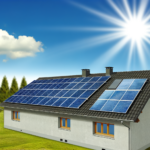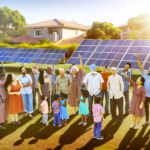Introduction to Solar Power
What is Solar Power?
Solar power is the conversion of sunlight into electricity using photovoltaic (PV) cells. These cells are typically made from silicon and other materials that can absorb photons from sunlight and release electrons, creating an electric current. Solar panels, which are composed of multiple PV cells, capture and convert sunlight into usable electrical energy. This energy can be used to power homes, businesses, and even vehicles, making it a versatile and renewable energy source.
Benefits of Solar Power
The adoption of solar power comes with a multitude of benefits:
- Environmental Impact: Solar power is a clean and renewable energy source. It produces no greenhouse gases or pollutants, significantly reducing your carbon footprint.
- Energy Independence: By generating your own electricity, you become less reliant on the grid and traditional energy sources, which can be subject to price fluctuations and supply issues.
- Cost Savings: While the initial investment can be substantial, solar power systems can lead to significant long-term savings on your electricity bills. Many systems pay for themselves over time through reduced energy costs.
- Low Maintenance: Solar power systems require minimal maintenance. With no moving parts, the risk of mechanical failure is low, and most systems come with long-term warranties.
- Increased Property Value: Homes equipped with solar power systems often see an increase in property value, making it a smart investment for homeowners.
Why Consider Solar Power?
There are several compelling reasons to consider adopting solar power:
- Sustainability: As the world grapples with climate change and the depletion of fossil fuels, solar power offers a sustainable alternative that can help mitigate environmental damage.
- Technological Advancements: Advances in solar technology have made systems more efficient and affordable than ever before. Innovations in solar panel design and energy storage solutions continue to improve the viability of solar power for a wide range of applications.
- Government Incentives: Many governments offer incentives, rebates, and tax credits to encourage the adoption of solar power. These financial benefits can significantly offset the initial costs of installation.
- Energy Security: Solar power provides a reliable source of energy that is not subject to geopolitical tensions or supply chain disruptions. This can be particularly important in regions prone to natural disasters or political instability.
- Community and Global Impact: By adopting solar power, you contribute to a larger movement towards renewable energy, helping to drive demand and innovation in the sector. This collective effort can lead to broader societal benefits, including job creation and economic growth in the renewable energy industry.
In summary, solar power is a viable and attractive option for those looking to reduce their environmental impact, achieve energy independence, and save on energy costs. With ongoing advancements in technology and supportive government policies, there has never been a better time to consider making the switch to solar energy.
Understanding Solar Power Systems
Components of a Solar Power System
A solar power system is composed of several key components that work together to convert sunlight into usable electricity. The primary components include:
- Solar Panels: These are the most visible part of the system, responsible for capturing sunlight and converting it into direct current (DC) electricity.
- Inverter: This device converts the DC electricity generated by the solar panels into alternating current (AC) electricity, which is what most home appliances use.
- Mounting System: This includes the racks and hardware used to secure the solar panels to your roof or ground installation.
- Battery Storage (optional): Batteries store excess energy generated during the day for use at night or during cloudy periods.
- Monitoring System: This system tracks the performance of your solar power system, providing real-time data on energy production and usage.
Types of Solar Power Systems
There are three main types of solar power systems, each with its own advantages and applications:
- Grid-Tied Systems: These systems are connected to the local utility grid, allowing you to use solar power when available and draw from the grid when necessary. Excess energy can be fed back into the grid, often earning you credits or payments from your utility company.
- Off-Grid Systems: These systems are completely independent of the utility grid and rely on battery storage to provide power when solar energy is not available. They are ideal for remote locations where grid access is not feasible.
- Hybrid Systems: Combining elements of both grid-tied and off-grid systems, hybrid systems are connected to the grid but also include battery storage. This setup provides greater flexibility and reliability, ensuring a continuous power supply even during grid outages.
How Solar Panels Work
Solar panels operate based on the photovoltaic (PV) effect, a process that converts sunlight into electricity. Here’s a simplified explanation of how it works:
- Sunlight Hits the Solar Panels: Solar panels are made up of many solar cells, typically composed of silicon. When sunlight strikes these cells, it excites the electrons in the silicon, creating an electric current.
- Generation of DC Electricity: The excited electrons flow through the solar cells, generating direct current (DC) electricity.
- Conversion to AC Electricity: The DC electricity flows to the inverter, which converts it into alternating current (AC) electricity suitable for home use.
- Distribution of Electricity: The AC electricity is then distributed throughout your home to power appliances, lights, and other electrical devices. Any excess electricity can be stored in batteries (if available) or fed back into the grid.
Understanding these components and how they work together is crucial for anyone considering solar power adoption. By familiarizing yourself with the basics, you can make informed decisions about the type of system that best suits your needs and how to optimize its performance.
Evaluating Your Solar Power Needs
Assessing Your Energy Consumption
Before diving into the world of solar power, it’s crucial to understand your current energy consumption. This step involves analyzing your electricity bills to determine your average monthly and annual usage. Look for the kilowatt-hours (kWh) used, as this will be a key metric in sizing your solar power system.
To get a more accurate picture, consider the following:
- **Seasonal Variations**: Energy usage can fluctuate with the seasons. For instance, air conditioning in the summer and heating in the winter can significantly impact your consumption.
- **Appliance Usage**: Identify which appliances consume the most energy. This can help you make informed decisions about energy efficiency improvements.
- **Future Changes**: Consider any future changes that might affect your energy usage, such as adding new appliances, expanding your home, or changes in household occupancy.
Determining the Right System Size
Once you have a clear understanding of your energy consumption, the next step is to determine the right size for your solar power system. The goal is to match your energy needs with the system’s output to maximize efficiency and cost-effectiveness.
Here are some key factors to consider:
- **Energy Offset**: Decide what percentage of your energy consumption you want to offset with solar power. While some aim for 100%, others might opt for a lower percentage to reduce initial costs.
- **System Efficiency**: Not all solar panels are created equal. Higher efficiency panels can generate more power in a smaller space, which is crucial if you have limited roof area.
- **Panel Degradation**: Solar panels degrade over time, typically losing about 0.5% to 1% efficiency per year. Factor this into your calculations to ensure long-term energy needs are met.
Considering Your Location and Climate
Your geographical location and local climate play a significant role in the performance of your solar power system. Solar panels rely on sunlight to generate electricity, so understanding how much sunlight your location receives is essential.
Consider the following:
- **Sunlight Hours**: The amount of sunlight your area receives, measured in peak sun hours, will directly impact your system’s efficiency. Areas with more sunlight will generate more power.
- **Weather Patterns**: Frequent cloudy or rainy days can reduce the effectiveness of your solar panels. However, modern panels are designed to work efficiently even in less-than-ideal conditions.
- **Roof Orientation and Shading**: The orientation and angle of your roof, as well as any potential shading from trees or buildings, can affect the amount of sunlight your panels receive. South-facing roofs with minimal shading are ideal.
By carefully evaluating your energy consumption, determining the right system size, and considering your location and climate, you can make informed decisions that will optimize your solar power investment. This thoughtful approach ensures that your transition to solar energy is both efficient and cost-effective, paving the way for long-term savings and sustainability.
Financial Aspects of Solar Power
Initial Costs and Investment
Investing in solar power involves several upfront costs, which can vary based on the size and type of system you choose. The primary expenses include the cost of solar panels, inverters, mounting hardware, and installation labor. On average, a residential solar power system can range from $15,000 to $25,000 before any incentives or rebates. While this may seem like a significant investment, it’s essential to consider the long-term benefits and savings that solar power can provide.
Government Incentives and Rebates
To make solar power more accessible, many governments offer various incentives and rebates. In the United States, the federal government provides the Investment Tax Credit (ITC), which allows homeowners to deduct a significant percentage of their solar installation costs from their federal taxes. Additionally, many states and local governments offer their own incentives, such as cash rebates, property tax exemptions, and performance-based incentives. These programs can substantially reduce the initial cost of your solar power system, making it a more attractive investment.
Long-term Savings and ROI
One of the most compelling reasons to invest in solar power is the potential for long-term savings. Once your system is installed, you can significantly reduce or even eliminate your monthly electricity bills. The exact savings will depend on your energy consumption, the size of your solar power system, and local electricity rates. On average, homeowners can expect to save tens of thousands of dollars over the lifespan of their solar panels, which typically last 25-30 years.
Moreover, the return on investment (ROI) for solar power systems is quite favorable. Most homeowners can expect to break even on their investment within 7-10 years, after which the savings continue to accumulate. Additionally, solar power systems can increase the value of your home, making it a wise financial decision in the long run.
In summary, while the initial costs of solar power can be substantial, government incentives and long-term savings make it a financially sound investment. By carefully evaluating the financial aspects, you can make an informed decision that benefits both your wallet and the environment.
Installation and Maintenance
DIY vs. Professional Installation
When it comes to installing a solar power system, you have two primary options: **DIY installation** or **professional installation**. Each approach has its own set of advantages and considerations.
**DIY Installation**:
– **Cost Savings**: One of the most significant benefits of DIY installation is the potential for cost savings. By eliminating labor costs, you can reduce the overall expense of your solar power system.
– **Learning Experience**: Installing your own solar panels can be a rewarding educational experience, providing you with a deeper understanding of how your system works.
– **Flexibility**: DIY installation allows you to work at your own pace and schedule.
However, DIY installation also comes with challenges:
– **Complexity**: Solar power systems can be complex, requiring knowledge of electrical systems and local building codes.
– **Time-Consuming**: The installation process can be time-consuming, especially for those without prior experience.
– **Warranty Issues**: Some manufacturers may void warranties if the system is not installed by a certified professional.
**Professional Installation**:
– **Expertise**: Professional installers have the experience and knowledge to ensure your system is installed correctly and efficiently.
– **Permits and Inspections**: Professionals can handle the necessary permits and inspections, ensuring compliance with local regulations.
– **Warranty Protection**: Many solar panel manufacturers require professional installation to maintain warranty coverage.
While professional installation may come with higher upfront costs, the peace of mind and potential long-term savings can make it a worthwhile investment.
Maintenance Tips for Longevity
To ensure your solar power system operates efficiently and lasts for many years, regular maintenance is essential. Here are some tips to help you maintain your system:
– **Regular Cleaning**: Dust, dirt, and debris can accumulate on solar panels, reducing their efficiency. Clean your panels with water and a soft brush or hire a professional cleaning service.
– **Inspect for Damage**: Periodically inspect your panels for any signs of damage, such as cracks or loose connections. Address any issues promptly to prevent further damage.
– **Monitor Performance**: Use a monitoring system to track your solar power output. Sudden drops in performance may indicate a problem that needs attention.
– **Check Inverter**: The inverter is a critical component of your solar power system. Ensure it is functioning correctly and check for any error messages.
– **Trim Nearby Trees**: Overhanging branches can cast shadows on your panels, reducing their efficiency. Keep trees trimmed to maximize sunlight exposure.
By following these maintenance tips, you can help ensure your solar power system remains efficient and reliable for years to come.
Troubleshooting Common Issues
Even with regular maintenance, you may encounter some common issues with your solar power system. Here are a few troubleshooting tips:
– **Low Power Output**: If your system is producing less power than expected, check for shading, dirty panels, or inverter issues. Clean the panels and ensure there are no obstructions.
– **Inverter Errors**: If your inverter displays an error message, consult the user manual for troubleshooting steps. Common issues include grid faults, isolation faults, and temperature warnings.
– **System Shutdown**: If your system shuts down unexpectedly, check the circuit breakers and fuses. Reset any tripped breakers and replace blown fuses.
– **Monitoring System Issues**: If your monitoring system is not providing accurate data, check the connections and ensure the software is up to date.
If you are unable to resolve an issue on your own, it may be best to contact a professional installer or technician for assistance. Regular maintenance and prompt attention to any problems can help keep your solar power system running smoothly.
Living with Solar Power
Adapting to a Solar-Powered Lifestyle
Transitioning to a solar-powered lifestyle involves more than just installing solar panels; it requires a shift in how you think about and use energy. One of the first changes you’ll notice is a heightened awareness of your energy consumption. Monitoring your energy use becomes second nature, as you aim to maximize the benefits of your solar investment.
To adapt smoothly, consider implementing energy-efficient practices such as using LED lighting, energy-efficient appliances, and smart home systems that optimize energy use. Additionally, being mindful of peak sunlight hours can help you schedule high-energy activities, like running the dishwasher or doing laundry, during times when your solar panels are generating the most power.
Maximizing Efficiency and Performance
To get the most out of your solar power system, it’s crucial to focus on efficiency and performance. Here are some tips to help you achieve this:
- Regular Maintenance: Keep your solar panels clean and free of debris to ensure they are operating at peak efficiency. Dust, leaves, and bird droppings can significantly reduce their effectiveness.
- Energy Storage: Consider investing in a battery storage system. This allows you to store excess energy generated during the day for use at night or during cloudy periods.
- Energy Monitoring: Use energy monitoring tools to track your system’s performance. This can help you identify any issues early and make necessary adjustments.
- System Upgrades: As technology advances, upgrading components like inverters or adding more panels can enhance your system’s efficiency.
Integrating Solar with Other Renewable Sources
For those looking to further reduce their carbon footprint, integrating solar power with other renewable energy sources can be a game-changer. Combining solar with wind turbines, for example, can provide a more consistent energy supply, as wind and solar resources often complement each other.
Another option is to incorporate geothermal energy for heating and cooling needs. Geothermal systems use the stable temperatures underground to regulate your home’s temperature, reducing the need for traditional HVAC systems and further lowering your energy consumption.
By diversifying your renewable energy sources, you not only increase your energy independence but also create a more resilient and sustainable energy system. This holistic approach can significantly enhance your overall energy efficiency and contribute to a greener future.
Future Trends in Solar Technology
Innovations in Solar Panel Design
The solar industry is continuously evolving, with significant advancements in solar panel design. One of the most notable innovations is the development of *bifacial solar panels*. Unlike traditional panels that capture sunlight on one side, bifacial panels can absorb light from both sides, increasing energy production by up to 30%. Additionally, *thin-film solar panels* are gaining traction due to their flexibility and lightweight nature, making them ideal for unconventional surfaces like curved roofs and even windows.
Another exciting development is the integration of *solar tiles* into building materials. Companies like Tesla have pioneered solar roof tiles that blend seamlessly with traditional roofing materials, providing an aesthetically pleasing alternative to bulky panels. These innovations not only enhance the efficiency of solar energy systems but also make them more adaptable to various architectural designs.
Emerging Solar Technologies
Beyond panel design, emerging solar technologies promise to revolutionize the industry. *Perovskite solar cells* are at the forefront of this revolution. These cells are cheaper to produce and have the potential to achieve higher efficiency rates than traditional silicon-based cells. Researchers are also exploring *organic photovoltaics (OPVs)*, which use organic molecules to capture sunlight. OPVs are lightweight, flexible, and can be produced using low-cost printing techniques.
Another groundbreaking technology is *solar paint*. This innovative solution involves applying a layer of photovoltaic material to surfaces, turning them into energy-generating assets. While still in the experimental stage, solar paint could offer a cost-effective and versatile way to harness solar energy.
The Future of Solar Power Adoption
The future of solar power adoption looks promising, driven by technological advancements and supportive policies. As solar technology becomes more efficient and affordable, it is expected to play a crucial role in the global transition to renewable energy. Governments worldwide are implementing policies and incentives to encourage solar adoption, such as tax credits, rebates, and feed-in tariffs.
Moreover, the rise of *community solar projects* is making solar power accessible to a broader audience. These projects allow individuals to invest in a shared solar system and receive credits on their electricity bills, even if they cannot install panels on their property. This model is particularly beneficial for renters and those with unsuitable roofs.
In conclusion, the future of solar technology is bright, with continuous innovations in panel design and emerging technologies paving the way for increased adoption. As solar power becomes more integrated into our daily lives, it will play a pivotal role in creating a sustainable and energy-efficient future.






